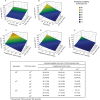Live-birth rates after HP-hMG stimulation in the long GnRH agonist protocol: association with mid-follicular hCG and progesterone concentrations, but not with LH concentrations
- PMID: 22809021
- PMCID: PMC3518295
- DOI: 10.3109/09513590.2012.705379
Live-birth rates after HP-hMG stimulation in the long GnRH agonist protocol: association with mid-follicular hCG and progesterone concentrations, but not with LH concentrations
Abstract
The aim of this retrospective study was to investigate the impact of endogenous and exogenous luteinizing hormone (LH) activity on treatment outcome, when taking into consideration potential confounding variables. Data were derived from IVF patients (n = 358) stimulated with highly purified menotrophin (HP-hMG) in a long gonadotrophin-releasing hormone (GnRH) agonist protocol. Simple retrospective logistic regression analysis showed that the mid-follicular exogenous concentrations of human chorionic gonadotrophin (hCG) (p = 0.027), provided by the HP-hMG preparation, and female age (p = 0.009) were significantly associated with live-birth rate, while the mid-follicular progesterone concentration (p = 0.075), the estradiol concentration on last stimulation day (p = 0.075) and number of embryos transferred (p = 0.071) were borderline significant. Endogenous LH was not associated with live-birth rate; neither at start of stimulation (p = 0.123), nor in the mid-follicular phase (p = 0.933) or on the last day of stimulation (p = 0.589). In the multiple regression analysis of life birth, mid-follicular hCG (p = 0.016) was identified as a positive predictor, and age (p = 0.004) and mid-follicular progesterone (p = 0.029) as negative predictors. In conclusion, mid-follicular concentrations of exogenous hCG and progesterone, but not endogenous LH, are associated with live-birth rate in IVF patients treated with HP-hMG in a long GnRH agonist cycle.
Figures

Similar articles
-
Basal serum progesterone and history of elevated progesterone on the day of hCG administration are significant predictors of late follicular progesterone elevation in GnRH antagonist IVF cycles.Hum Reprod. 2016 Aug;31(8):1859-65. doi: 10.1093/humrep/dew141. Epub 2016 Jun 14. Hum Reprod. 2016. PMID: 27301360
-
Exogenous hCG activity, but not endogenous LH activity, is positively associated with live birth rates in anovulatory infertility.Hum Fertil (Camb). 2011 Sep;14(3):192-9. doi: 10.3109/14647273.2011.587135. Epub 2011 Jul 7. Hum Fertil (Camb). 2011. PMID: 21732905 Free PMC article. Clinical Trial.
-
Endocrine profile in serum and follicular fluid differs after ovarian stimulation with HP-hMG or recombinant FSH in IVF patients.Hum Reprod. 2007 Mar;22(3):676-87. doi: 10.1093/humrep/del445. Epub 2006 Nov 16. Hum Reprod. 2007. PMID: 17110397 Clinical Trial.
-
In vitro fertilisation. A review of drug therapy and clinical management.Drugs. 1996 Sep;52(3):313-43. doi: 10.2165/00003495-199652030-00002. Drugs. 1996. PMID: 8875126 Review.
-
Benefits of luteinizing hormone activity in ovarian stimulation for IVF.Reprod Biomed Online. 2009;18 Suppl 2:31-6. doi: 10.1016/s1472-6483(10)60446-4. Reprod Biomed Online. 2009. PMID: 19406029 Review.
Cited by
-
The influence of the pharmaceutical industry on the development of gonadotrophins and ovarian stimulation protocols in assisted reproductive technologies.Front Endocrinol (Lausanne). 2025 Apr 4;16:1536844. doi: 10.3389/fendo.2025.1536844. eCollection 2025. Front Endocrinol (Lausanne). 2025. PMID: 40255498 Free PMC article. Review.
-
A randomized, controlled, first-in-patient trial of choriogonadotropin beta added to follitropin delta in women undergoing ovarian stimulation in a long GnRH agonist protocol.Hum Reprod. 2022 May 30;37(6):1161-1174. doi: 10.1093/humrep/deac061. Hum Reprod. 2022. PMID: 35451013 Free PMC article.
-
The effect of human chorionic gonadotrophin contained in human menopausal gonadotropin on the clinical outcomes during progestin-primed ovarian stimulation.Oncotarget. 2017 Aug 24;8(50):87340-87352. doi: 10.18632/oncotarget.20508. eCollection 2017 Oct 20. Oncotarget. 2017. PMID: 29152085 Free PMC article.
References
-
- Balasch J, Fábregues F, Casamitjana R, Peñarrubia J, Vanrell JA. A pharmacokinetic and endocrine comparison of recombinant follicle-stimulating hormone and human menopausal gonadotrophin in polycystic ovary syndrome. Reprod Biomed Online. 2003;6:296–301. - PubMed
-
- Fleming R, Lloyd F, Herbert M, Fenwick J, Griffiths T, Murdoch A. Effects of profound suppression of luteinizing hormone during ovarian stimulation on follicular activity, oocyte and embryo function in cycles stimulated with purified follicle stimulating hormone. Hum Reprod. 1998;13:1788–1792. - PubMed
-
- Griesinger G, Dawson A, Schultze-Mosgau A, Finas D, Diedrich K, Felberbaum R. Assessment of luteinizing hormone level in the gonadotropin-releasing hormone antagonist protocol. Fertil Steril. 2006;85:791–793. - PubMed
-
- Strehler E, Abt M, El-Danasouri I, De Santo M, Sterzik K. Impact of recombinant follicle-stimulating hormone and human menopausal gonadotropins on in vitro fertilization outcome. Fertil Steril. 2001;75:332–336. - PubMed
-
- Westergaard LG, Erb K, Laursen SB, Rex S, Rasmussen PE. Human menopausal gonadotropin versus recombinant follicle-stimulating hormone in normogonadotropic women down-regulated with a gonadotropin-releasing hormone agonist who were undergoing in vitro fertilization and intracytoplasmic sperm injection: a prospective randomized study. Fertil Steril. 2001;76:543–549. - PubMed
MeSH terms
Substances
LinkOut - more resources
Full Text Sources
Medical
Research Materials
Miscellaneous
